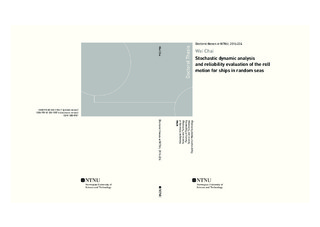| dc.contributor.advisor | Næss, Arvid | |
| dc.contributor.advisor | Leira, Bernt | |
| dc.contributor.author | Chai, Wei | |
| dc.date.accessioned | 2016-09-09T11:04:59Z | |
| dc.date.available | 2016-09-09T11:04:59Z | |
| dc.date.issued | 2016 | |
| dc.identifier.isbn | 978-82-326-1787-6 | |
| dc.identifier.issn | 1503-8181 | |
| dc.identifier.uri | http://hdl.handle.net/11250/2405762 | |
| dc.description.abstract | Large amplitude roll motion in realistic seas is a serious threat to ship stability because
it can lead to damage or even capsizing of the vessel. For the excessive roll motion in
random seas, the nonlinear effects and dynamics associated with damping and restoring
terms should be considered. Currently, the criteria of the International Maritime
Organization (IMO) for evaluation of the intact stability are based on both hydrostatics
and dynamics (IMO, 2008). However, due to the stochastic nature of the ocean
environment and the randomness of the roll response, the assessment of extreme rolling
should inevitably be based on dynamic considerations and probabilistic methods. With
the awareness of the deficiencies of the current criteria for intact stability evaluation,
the IMO is currently developing the next generation (also second generation) of such
criteria with a certain consideration of the physics associated with the dynamics of
nonlinear roll motion and the randomness of the ocean environment and roll response.
In this work, probabilistic methods are proposed for studying the nonlinear behavior of
the random roll motion as well as for evaluating the dynamic stability of the vessel in
random seas. The problems of dead ship condition in random beam seas and parametric
roll in random head seas are studied. For the first problem, the Markov theory is applied
in order to study the stochastic nonlinear roll response. Specifically, the rolling behavior
is described by a single-degree-of-freedom (SDOF) model which incorporates the
nonlinearities associated with the damping and restoring terms as well as the
randomness of the wave excitation. The linear filter technique is employed to
approximate the random external excitation and then the SDOF model is extended into
a four-dimensional (4D) Markov system whose probabilistic properties are governed
by the Fokker-Planck (FP) equation. Based on the Markov property of the coupled
dynamic system, the 4D path integration (PI) method is introduced in order to solve the
high-dimensional FP equation. The numerical robustness and high efficiency of the 4D
PI method are evaluated by comparing with the results from Monte Carlo simulation
(MCS).
Based on the PI method and the MCS method, the feasibility of applying the secondorder
linear filter and the Gaussian white noise to approximate the random external
excitation are studied. The 4D dynamic system is shown to be an appropriate model for
studying the stochastic roll response. With the assistance of the 4D PI method, the
influence of ship parameters and wind excitation on the stochastic roll response are
investigated. Furthermore, the reliability evaluation associated with high response
levels is studied and long-term extreme response is predicted by combing the 4D PI
method with the metocean description.
In the second part of the thesis, the Grim effective wave model is introduced in order to approximate the variation of the restoring moment in random head seas. Based on
the Grim effective wave approximation, the mathematical model for describing the
rolling behavior is established. The linear filter technique and an efficient MCS method
are applied to predict the extreme roll response of a vessel sailing in random head seas.
It is demonstrated that the efficient MCS method is able to provide satisfactory
estimation of the extreme roll response with a dramatic reduction of computation time,
which is important for the subsequent long-term statistical evaluation.
The probabilistic methods mentioned above and the results and conclusions obtained in
this work hopefully can provide a useful reference for the second generation IMO intact
stability criteria which are currently being developed as well as for stochastic dynamic
analysis of nonlinear systems. | nb_NO |
| dc.language.iso | eng | nb_NO |
| dc.publisher | NTNU | nb_NO |
| dc.relation.ispartofseries | Doctoral thesis at NTNU;2016:224 | |
| dc.relation.haspart | Paper 1: Chai, Wei; Næss, Arvid; Leira, Bernt Johan. Stochastic Dynamic Analysis and Reliability of a Vessel Rolling in Random Beam Seas. Journal of Ship Research 2015 ;Volum 59.(2) s. 113-131
Is not included due to copyright available at
<a href="http://dx.doi.org/10.5957/JOSR.59.2.140059" target="_blank"> http://dx.doi.org/10.5957/JOSR.59.2.140059</a> | nb_NO |
| dc.relation.haspart | Paper 2: Chai, Wei; Næss, Arvid; Leira, Bernt Johan. Filter models for prediction of stochastic ship roll response. Probabilistic Engineering Mechanics 2015 ;Volum 41. s. 104-114
<a href="http://dx.doi.org/10.1016/j.probengmech.2015.06.002" target="_blank"> htsciencedirect.comtp://dx.doi.org/10.1016/j.probengmech.2015.06.002</a>
The article in is reprinted with kind permission from Elsevier, | nb_NO |
| dc.relation.haspart | Paper 3: Chai, Wei; Næss, Arvid; Leira, Bernt Johan. Stochastic nonlinear ship rolling in random beam seas by the path integration method. Probabilistic Engineering Mechanics 2016 ;Volum 44. s. 43-52
<a href="http://dx.doi.org/10.1016/j.probengmech.2015.10.002" target="_blank"> http://dx.doi.org/10.1016/j.probengmech.2015.10.002</a>
The article in is reprinted with kind permission from Elsevier, sciencedirect.com | nb_NO |
| dc.relation.haspart | Paper 4: Chai, Wei; Næss, Arvid; Leira, Bernt Johan. Stochastic roll response for a vessel with nonlinear damping models and steady heeling angles in random beam seas. Ocean Engineering 2016 ;Volum 120. s. 202-211
<a href="http://dx.doi.org/10.1016/j.oceaneng.2016.05.019" target="_blank"> http://dx.doi.org/10.1016/j.oceaneng.2016.05.019</a>
The article in is reprinted with kind permission from Elsevier, sciencedirect.com | nb_NO |
| dc.relation.haspart | Paper 5: Chai, Wei; Næss, Arvid; Leira, Bernt Johan; Bulian, Gabriele. Efficient Monte Carlo simulation and Grim effective wave model for predicting the extreme response of a vessel rolling in random head seas. Ocean Engineering 2016 ;Volum 123. s. 191-203
<a href="http://dx.doi.org/10.1016/j.oceaneng.2016.07.025" target="_blank"> http://dx.doi.org/10.1016/j.oceaneng.2016.07.025</a>
The article in is reprinted with kind permission from Elsevier, sciencedirect.com | nb_NO |
| dc.title | Stochastic dynamic analysis and reliability evaluation of the roll motion for ships in random seas | nb_NO |
| dc.type | Doctoral thesis | nb_NO |
| dc.subject.nsi | VDP::Technology: 500::Marine technology: 580 | nb_NO |

